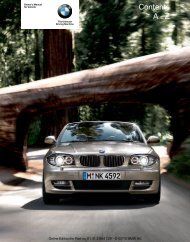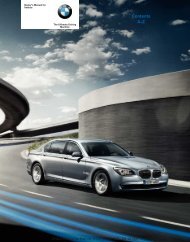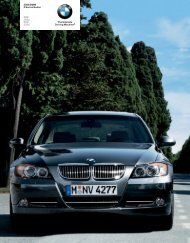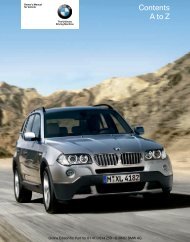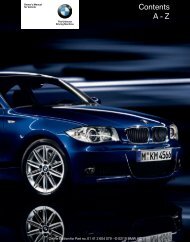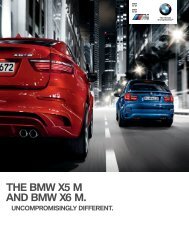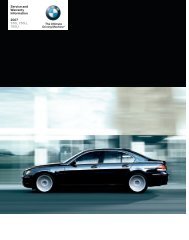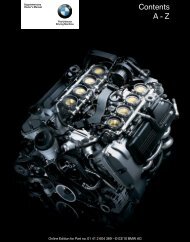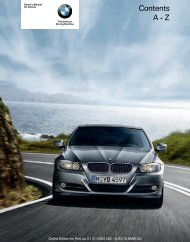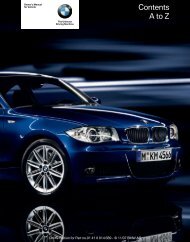2011 3 Series Owner's Manual without iDrive - Irvine BMW
2011 3 Series Owner's Manual without iDrive - Irvine BMW
2011 3 Series Owner's Manual without iDrive - Irvine BMW
Create successful ePaper yourself
Turn your PDF publications into a flip-book with our unique Google optimized e-Paper software.
Wheels and tires<br />
Wheels and tires<br />
Tire inflation pressures<br />
Information for your safety<br />
It is not merely the tires' service life, but also<br />
driving comfort and, to a great extent, driving<br />
safety that depend on the condition of the tires<br />
and the maintenance of the specified tire pressure.<br />
Check the tire inflation pressure regularly<br />
and correct it, if necessary: at least twice a<br />
month and before starting long trips. If you fail<br />
to observe this precaution you may be driving<br />
on tires with incorrect tire pressures, a condition<br />
that can not only compromise your vehicle's<br />
driving stability, but also lead to tire damage<br />
and the risk of an accident. Do not drive<br />
with deflated, i.e. flat tires, except when using<br />
run-flat tires. A flat tire will seriously impair your<br />
vehicle's handling and braking response.<br />
Attempts to drive on a flat tire can lead to loss of<br />
control over the vehicle.<<br />
For correct identification of the right tire inflation<br />
pressures, observe the following:<br />
> Tire sizes for your vehicle<br />
> Load conditions<br />
> Maximum allowable driving speed<br />
Tire inflation pressures for driving<br />
up to 100 mph or 160 km/h<br />
For normal driving up to 100 mph or 160 km/h<br />
and to achieve optimum driving comfort, adjust<br />
pressures to the respective tire inflation pressures<br />
listed on the following pages in the columns<br />
for traveling speeds up to a maximum of<br />
100 mph or 160 km/h.<br />
These tire inflation pressures can also be found<br />
on the driver's side door post when the driver's<br />
door is open.<br />
Checking pressure<br />
Only check tire inflation pressure when the<br />
tires are cold. This means after a maximum of<br />
1.25 miles/2 km driving or when the vehicle has<br />
been parked for at least 2 hours. When tires are<br />
warm, the tire inflation pressure is higher.<br />
After correcting the tire inflation pressure,<br />
reset the Tire Pressure Monitor, refer to<br />
page 85, or reinitialize the Flat Tire Monitor,<br />
refer to page 83.<<br />
Inflation pressure specifications<br />
The tables below provide all the correct inflation<br />
pressures for the specified tire sizes at ambient<br />
temperature.<br />
The inflation pressures apply to the tire<br />
sizes approved and tire brands recommended<br />
by <strong>BMW</strong>; a list of these is available<br />
from your <strong>BMW</strong> center.<<br />
130<br />
The maximum permissible speed for<br />
these tire pressures is 100 mph or<br />
160 km/h. Do not exceed this speed; otherwise,<br />
tire damage and accidents could occur.<<br />
Tire inflation pressures for driving<br />
above 100 mph or 160 km/h<br />
In order to drive at maximum speeds in<br />
excess of 100 mph or 160 km/h, adjust<br />
pressures to the respective tire inflation pressures<br />
listed on the following pages in the columns<br />
for traveling speeds including those<br />
exceeding 100 mph or 160 km/h. Otherwise,<br />
tire damage and accidents could occur.<<br />
Observe all national and local maximum speed<br />
limits; otherwise, violations of the laws could<br />
occur.



